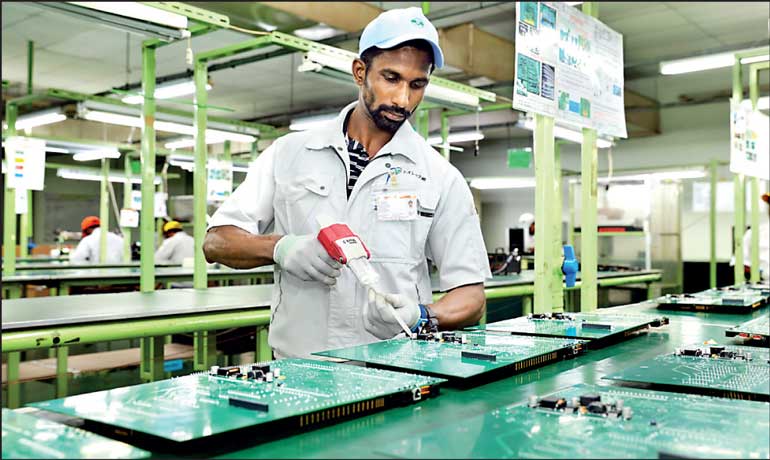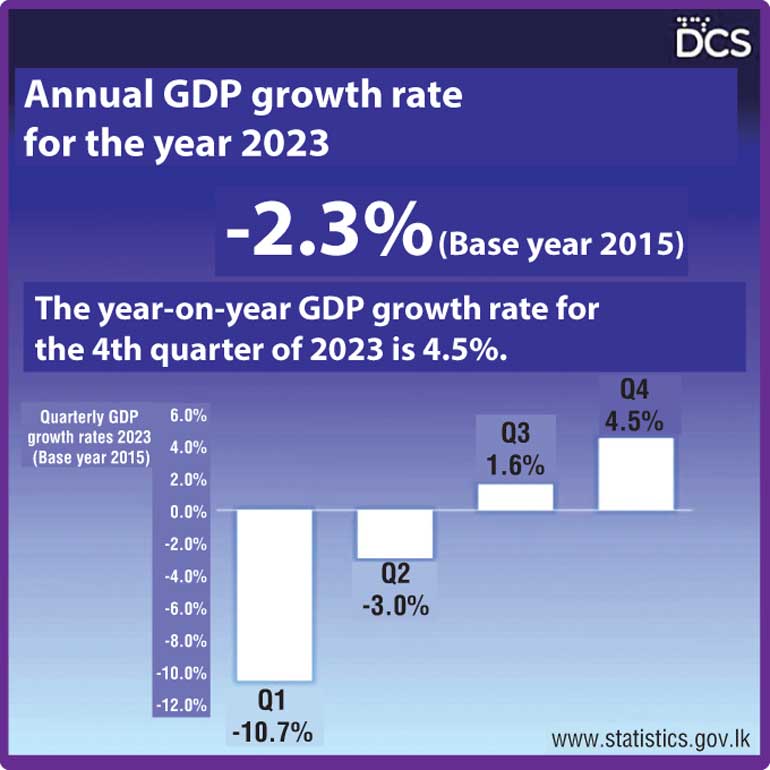Monday Apr 07, 2025
Monday Apr 07, 2025
Saturday, 16 March 2024 00:15 - - {{hitsCtrl.values.hits}}

The Industrial sector grew at a high 7.9% in the fourth quarter though finishing 2023 with 9.2% contraction
Sri Lanka’s economy grew sharply by 4.5% year on year in the four quarter but ended 2023 with a 2.3% contraction, the Department of Census and Statistics (DCS) revealed yesterday.
The overall Agricultural activities in 2023 expanded by 2.6% while Industrial and Services activities contracted by 9.2% and 0.2% respectively.
Services sector accounted for 59.9% of GDP in 2023 and Industry’s share was 8.3% whilst Agriculture accounted for 8.3%. Taxes less subsidies on products’ components contributed 6.2%.
In the 4th quarter of 2023 the economy bounced back by reporting a 4.5% positive growth rate compared to the reported 12.4% negative growth rate in the same quarter of 2022. In the fourth quarter of 2023 Agricultural, Industrial and Services activities grew by 0.6%, 7.9% and 2.8% respectively.
The 4Q growth of 4.5% was in comparison to 1.6% in 3Q and negative growth of 3% and 10.7% in the preceding quarters of 2023. In 2022 the economy suffered the worst contraction of 7.8%.
DCS said “Sri Lanka’s economy experienced some kind of duality in 2023 since the first half of the year the economy recorded negative growth while for the rest of the half, the economy bounced back to report a positive growth.”


It said in the midst of 2023 the uncertainty about the exchange rate which was observed for a while was transformed creating stability in foreign currency inflows through workers’ remittances. Furthermore the long-awaited boom in tourism was coming towards the end of the year by strengthening the expectations of a good economy.
However, it was observed that some of the economic activities such as manufacturing industries and construction industry have been affected adversely due to the prevailing high input prices. Further, when compared to the previous year, for most of the agriculture activities, availability of inputs without shortage, has been affected to report favourable growth rates in many crops and paddy cultivation.
In addition, the Gross Domestic Product of Sri Lanka for the year 2023 at current prices increased up to Rs. 27,629,665 million from Rs. 24,063,762 million which was recorded in the year 2022 registering 14.8% of positive change in the GDP at current prices.
For the year 2023, overall Agricultural activities expanded by 2.6% while Industrial and Services activities contracted by 9.2% and 0.2% respectively in the year 2023.
Following is the brief commentary from DCS as to how the key sectors of the economy performed in 2023.
Performance in Agricultural activities
In the year 2023, the overall Agriculture activities reported an expansion of 2.6% when compared to the 4.2% of negative growth recorded in the year 2022.
The expansion in the agricultural activities were mainly driven by ‘Growing of rice’ (20.0%), ‘Growing of other perennial crops’ (8.9%), ‘Growing of fruits’ (7.2%), ‘Marine fishing and marine aquaculture’ (4.9%), ‘Growing of vegetables’ (3.2%), ‘Growing of cereals’ (2.9%), ‘Animal production’ (1.8%) and ‘Agricultural supporting activities’ (1.5%). Whereas some agricultural economic activities, for instance ‘Plant propagation’ (24.7%), ‘Growing of rubber’ (7.7%), ‘Growing of sugar cane and tobacco’ (7.6%), ‘Growing of coffee, cocoa and other beverage crops’ (7.6%), ‘Forestry and logging’ (7.3%), ‘Growing of oleaginous fruits’ (3.6%), ‘Fresh water fishing and fresh water aquaculture’ (3.4%), ‘Growing of spices’ (1.7%) and ‘Growing of tea (1.5%) marked negative growth rates in 2023.
Performance in Industrial activities
For the year 2023, Industrial activities contracted by 9.2% further by deepening the 16.0% decline which was disclosed for the previous year.
Within the ‘Industrial activities’, ‘Construction’ (20.8%) and ‘Mining and quarrying’ (22.3%) activities have been contracted during the year 2023. Meanwhile, the overall manufacturing industry declined by 3.2%. However, few manufacturing activities reported expansions in the year 2023 while most of the manufacturing activities reported declines; such as ‘Manufacture of wood and wood products’ (20.0%), ‘Manufacture of rubber and plastic products’ (16.8%), ‘Other manufacturing and repair and installation of machinery and equipment’ (15.6%), ‘Manufacture of machinery and equipment’ (15.1%), ‘Manufacture of textiles, wearing apparel, leather and other related products’ (12.0%), ‘Manufacture of paper and paper products’ (9.2%), ‘Manufacture of furniture’ (7.8%) and ‘Manufacture of other non-metallic mineral products’(0.6%) . However, few manufacturing activities namely; ‘Manufacture of coke and refined petroleum products’(238.2%), ‘Manufacture of food, beverages and tobacco products’ (3.5%), ‘Manufacture of basic metal and fabricated metal products’ (2.6%) and ‘Manufacture of chemical products and basic pharmaceutical products’ (0.7%) recorded positive growth rates in the year 2023.
The other two components of industrial activities ‘Electricity, gas, steam and air conditioning supply’ and ‘Water collection, treatment and supply’ reported declines of 2.3% and 17.6% respectively in 2023.
Performance in Services activities
In the year 2023, the Services sector contracted for the second consecutive year, edging down 0.2% when compared to 2.6% shrinkage reported in the year 2022.
To demonstrate this decline, ‘IT programming consultancy and related activities’ (21.4%), ‘Financial service activities’(10.0%), ‘Real estate activities and ownership of dwelling’ (6.0%), ‘Telecommunication’ (2.2%), ‘Programming and broadcasting activities’ (2.1percent), ‘Public administration and defence’(1.7%), ‘Human health services’ (0.7%) have contributed. However some Services activities reported expansions in the year 2023, namely; ‘Accommodation, food and beverage serving activities’ (26.0%), ‘Insurance services’(26.0), ‘Transportation of goods and passengers including warehousing’ (3.9%), ‘Postal and courier services’ (2.9%), ‘Professional services’ (2.4%), ‘Education’ (1.8%), ‘Other personal services’ (0.4%) and ‘Wholesale and retail trade’ (0.1%) .